Concrete Parking Lot Repair – 12 Steps to Ensure Safety
A well-maintained concrete parking lot is crucial for safety and aesthetics. Regular repairs prevent potential hazards and enhance your business’s first impression.
Concrete parking lot repair involves fixing cracks, potholes, and wear to maintain a smooth, safe surface. Timely repairs prevent minor damages from escalating into major issues, saving costs in the long run. It’s not just about aesthetics; it’s a safety matter. Addressing issues promptly ensures a welcoming and secure environment for visitors and protects vehicles from damage.
Discover the importance of timely repairs, best practices, and maintenance tips to keep your concrete parking lot in top condition.
How to Repair a Concrete Parking Lot in 12 Steps
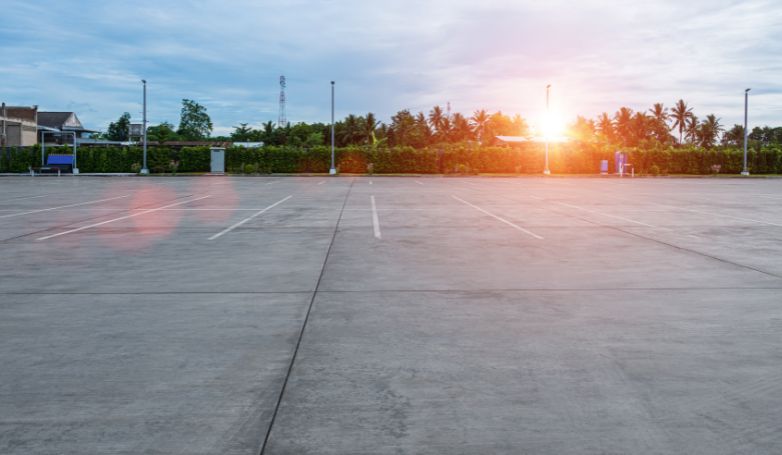
To help you navigate this process, here’s a comprehensive 12-step guide for concrete parking lot repair. These steps cover everything from initial assessment to the final markings, ensuring a thorough and professional approach to maintaining your parking area.
1. Assessment
Begin by thoroughly assessing the condition of the parking lot. Look for visible signs of damage such as cracks, potholes, and areas of wear and tear. This step is crucial in determining the extent of the repair work needed. Note the severity and location of damages, as this will guide your repair strategy and material requirements, ensuring a comprehensive and effective repair process.
2. Safety Precautions
Before starting repairs, implement necessary safety precautions. Set up barriers and signs to redirect traffic and pedestrians, ensuring no one inadvertently enters the repair area. Safety is paramount, not only for the workers but also for the general public. Wear appropriate personal protective equipment such as gloves, safety glasses, and hard hats to prevent accidents and injuries during the repair process.
3. Cleaning
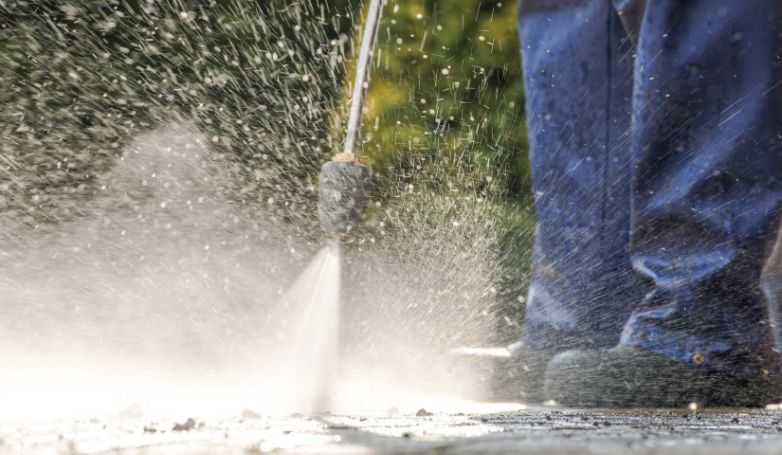
To initiate a successful concrete parking lot repair, it’s crucial to start with a clean surface. Thoroughly remove debris, dirt, and loose particles using a broom, pressure washer, or blower. This meticulous cleaning ensures the repair materials adhere properly to the existing concrete. It also aids in uncovering smaller cracks and damages concealed under dirt or debris, leading to a more comprehensive and enduring repair of the concrete parking lot.
4. Crack Repair
Address all cracks in the concrete. For smaller cracks, use a crack filler or sealant. For larger cracks, a more robust concrete patching compound may be needed. Apply the repair material carefully, filling the cracks completely, and smooth it out for an even surface. Proper crack repair prevents water infiltration and further deterioration, extending the lifespan of the parking lot.
5. Pothole Repair
Repair potholes by first removing any loose material. Then, fill them with a high-quality concrete patching compound. Tamp down the patch to ensure it is compact and level with the surrounding surface. Pothole repair is crucial as they pose significant tripping hazards and can cause damage to vehicles, potentially leading to liability issues for the property owner.
6. Surface Preparation
Prepare the surface by etching or grinding, especially where new concrete will adhere to old. This roughens the surface, improving the bond between the old and new concrete. Ensure the surface is dry and free of any substances that could hinder adhesion. Proper surface preparation is key to the longevity and effectiveness of the repair.
7. Bonding Agent
Apply a concrete bonding agent to the area to be repaired. This agent enhances the adhesion between the existing concrete and the new repair material. Ensure an even application and allow it to become tacky before proceeding. The bonding agent is crucial for a seamless repair and prevents future delamination of the repair area.
8. Concrete Mix
For effective concrete parking lot repair, it’s essential to prepare the concrete mix as per the manufacturer’s guidelines, targeting the ideal consistency. The mix should be pliable but not overly fluid. Opt for a high-quality mix that aligns with the strength and endurance of the existing parking lot surface. Accurate mixing is key to ensuring that the repaired area can endure the same conditions as the rest of the parking lot, maintaining uniformity in durability and appearance.
9. Pouring and Finishing
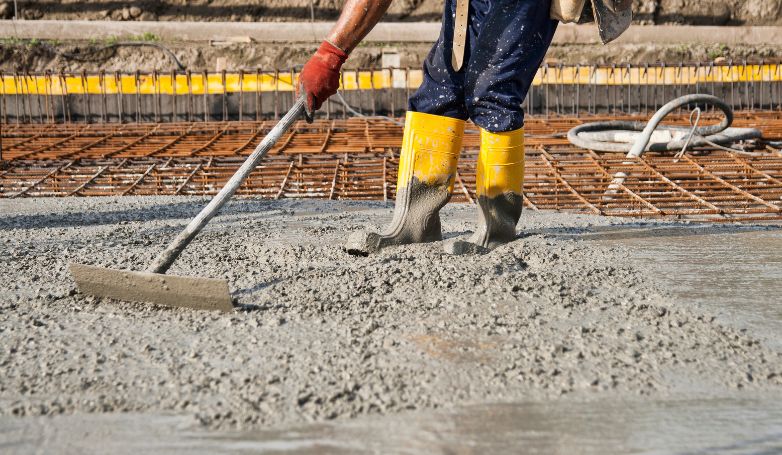
Pour the concrete mix into the prepared areas. Use tools like trowels and floats to spread the material evenly, ensuring a smooth, level surface. This step requires precision and care to match the level and texture of the surrounding area. A well-finished surface ensures a uniform look and prevents future issues like water pooling.
10. Curing
Allow the concrete to cure properly, a process that can take several days. Keep the area moist or covered to ensure even curing and prevent cracking. Curing is critical for the material to reach its maximum strength and durability, making it crucial for the longevity of the repair.
11. Sealing
After curing, apply a concrete sealer. This protects the surface from water penetration, stains, and wear. Sealing extends the lifespan of the material and maintains its appearance. It also reduces maintenance costs by protecting the surface from elements that cause deterioration.
12. Striping and Marking
Concluding the concrete parking lot repair, it’s important to reapply any essential striping and marking. This step encompasses redoing parking spaces, handicap zones, and directional arrows. Employ high-quality, weather-resistant paint to ensure the markings are clear and enduring. Properly executed striping and marking are crucial for maintaining efficient traffic flow and compliance with legal standards for parking lots.
Why choose a concrete Parking Lot?
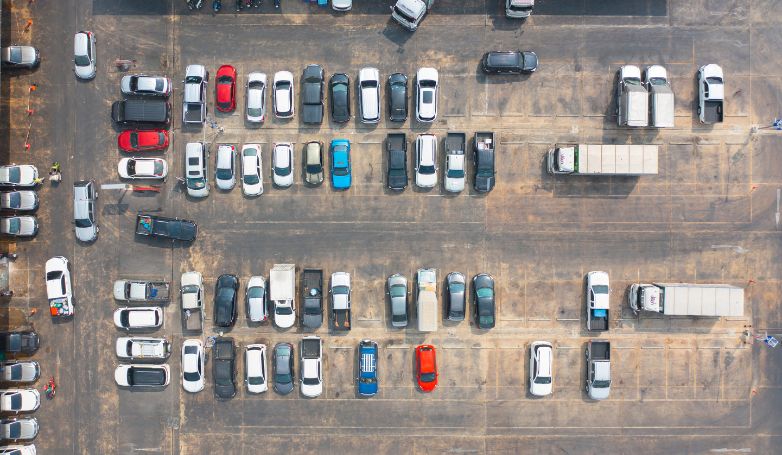
Concrete parking lots provide a clean, durable parking surface inviting to prospective tenants and their customers. A concrete parking lot offers many desirable qualities for large areas.
- Concrete stands out as a robust material, ideal for areas with high traffic and heavy truck use, due to its resilience under substantial loads. It’s particularly effective in colder climates, resistant to issues like rutting and frost heaves. Additionally, its durability against the constant impact of heavy vehicles is a significant advantage.
- This material is low-maintenance compared to other types of pavement, making repairs more cost-effective. Furthermore, concrete is immune to rusting, rotting, or burning, which translates to energy and resource savings in terms of building and infrastructure maintenance.
- A Department of Transportation study highlights concrete’s minimal environmental impact over its lifespan, credited to lower energy requirements. Moreover, the Construction Materials Recycling Association notes that approximately 140 million tons of concrete are recycled annually in the U.S., significantly reducing the environmental footprint of construction projects.
- Concrete also offers enhanced reflectivity, contributing to brighter and more energy-efficient spaces.
The most common concrete parking lot issues
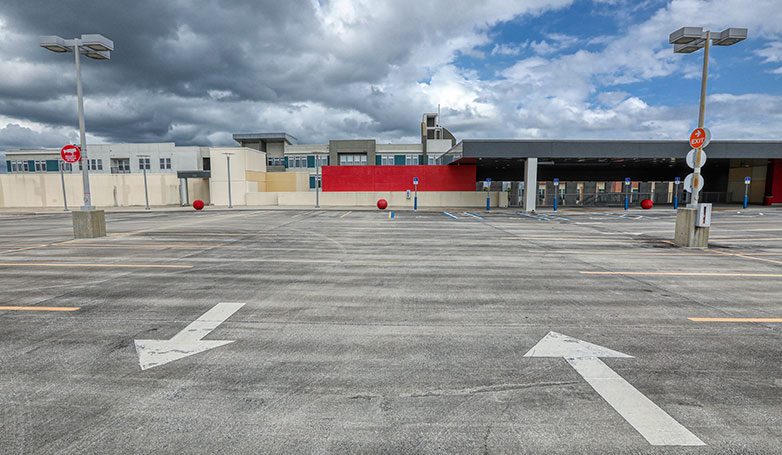
Unlike asphalt, this material is not pliable, making it much less forgiving when it comes to heaving from freeze and thaw cycles. The elements cause deterioration. Oxidization from the sun, rain, and snow, freeze and thaw cycles and the amount of traffic the parking lot receives cause issues that make concrete parking lot repair necessary.
Cracking
Concrete, while robust, is susceptible to cracking under extreme pressure, with major repairs potentially costly. In colder climates, the freeze-thaw cycle can cause the material to expand and contract, leading to cracks. Early detection and immediate patching are vital to prevent the spread and worsening of these cracks, ensuring the longevity and safety of the parking lot.
Salt Damage
This material can suffer significant damage from road salt. Over time, salt induces corrosion beneath the surface, leading to crumbling or more extensive cracking. This issue is particularly prevalent in areas with heavy winter salt use, making regular inspections and maintenance essential to mitigate the harmful effects of salt on concrete surfaces.
Flaking
In areas subject to freeze-thaw cycles, concrete parking lot repair becomes necessary when flaking occurs. This flaking can also result from too much water in the concrete mix at the time of installation. Not only does flaking diminish the aesthetic of the parking lot, but it may also indicate more serious structural issues. Addressing this promptly is crucial to halt further deterioration and maintain the integrity of the concrete parking lot.
Potholes
Potholes occur when contraction and expansion of the soil under the pavement take place. These happen when there has been significant rain or snow. Water will seep down through cracks and can settle underneath pavement surfaces. In winter, water freezes and expands. As temperatures warm, the ice may melt to create a void. Potholes will form as the paving material and soil over the opening breaks down.
Tips on how to maintain a concrete parking lot
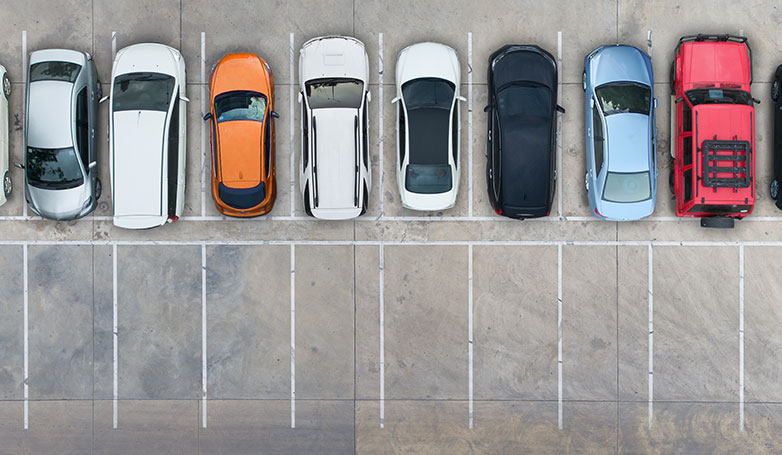
The goal of any concrete parking lot repair should be to maximize the life expectancy as much as possible before removing and replacing it completely. Regular upkeep, including timely repairs, is vital for the long-term health of any paved area. Studies consistently show that such ongoing attention can substantially increase the lifespan of these surfaces.
Here are things you should plan on regularly doing:
Remove oil stains
Oil, grease, and other petroleum substances can damage the surface of the parking lot. While grime will not cause severe structural damage, these stains can worsen over time and become permanent. Cleaning your parking lot will ensure your concrete’s appearance. Clean concrete lasts longer and creates a better impression on your potential customers.
Clean oil spots with a commercial de-greaser, a rigid bristle broom or brush, and some hot water. You’ll need to brush and rinse a few times to get all of the oil off, but in the end, it’s well worth the effort. Just be sure to rinse off all of the de-greaser when you’re finished.
Remove long-standing stains
Long-standing Stains can be removed from concrete with dry or mechanical methods or wet methods using chemical or water.
Standard dry methods include sandblasting, flame cleaning and shot blasting, grinding, scabbing, planing, and scouring. Use Steel-wire brushes with care because they can leave metal particles on the surface that later will rust and stain concrete surfaces.
Wet stain removal methods require the application of specific chemicals tailored to the nature of the stain. The chemical treatment will either dissolve the staining substance to be blotted up from the concrete’s surface or bleach the staining substance so it will not show.
Seal the cracks in the concrete
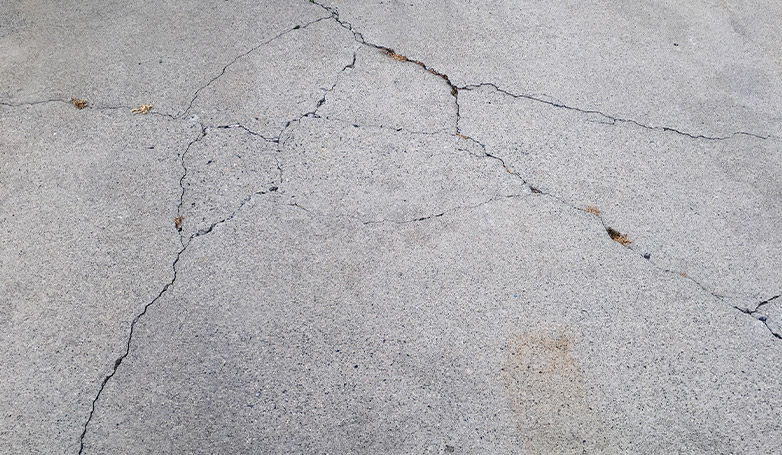
When cracks do develop, you should seal them with a concrete crack sealer. Sealing the cracks will help to prevent further damage and failures like potholes by avoiding or minimizing the amount of water entering them. The best maintenance plan should include concrete parking lot repair by crack sealing services each year.
Ensure Proper Drainage
Good drainage is essential for preventing water accumulation that can weaken the parking lot surface. Ensure your lot has adequate slopes and drains to avoid puddles. Regularly check and clean these drains to prevent blockages, which can cause water to pool and seep into the concrete, leading to potential damage.
Sweep and power wash regularly
Consistent sweeping removes harmful debris and dirt, while yearly power washing keeps the surface clean and minimizes wear. This regular maintenance can significantly prevent the deterioration of the concrete, keeping it in prime condition. Think of it as a regular health check-up for your parking lot, ensuring it stays functional and visually appealing for years.
Trim Vegetation Along the Edges
Regularly trimming vegetation around your parking lot’s edges not only enhances its appearance but also prevents root growth from damaging the concrete. Overgrown roots can cause cracks and uplifts, so keeping bushes and trees neatly trimmed is as much about aesthetics as it is about maintaining the structural integrity of your parking area.
Re-surface the concrete parking lot
To maintain your concrete parking lot in top condition, consider resurfacing it every 2 to 3 years. This process effectively slows down deterioration and is more economical compared to extensive repairs or complete replacement. It’s important to select a high-quality commercial-grade sealer and collaborate with a reputable pavement contractor to achieve the best results for your concrete parking lot repair and maintenance.
The cost of concrete parking or repairs and maintenance
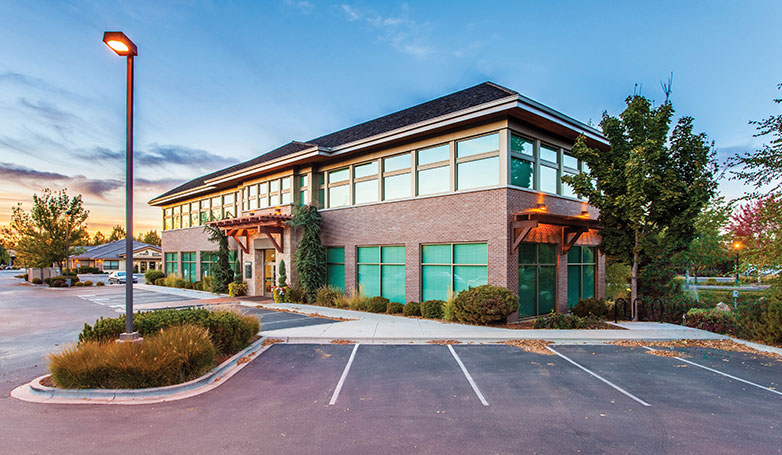
Concrete parking lot repair and maintenance costs vary depending on many factors. The prices of services are not the same nationwide. You can expect to pay more in a city location than you will in a rural or suburban area.
Concrete parking lot repair costs
There is no one best way to estimate the cost of many concrete parking lot repairs. A pavement maintenance contractor will conduct an on-site inspection to assess the damage and determine the best course of action. A contractor will take several factors into consideration that may impact the cost of your project, including:
- Current condition of the parking area
- Type and Severity of the damage
- Local labor and material rates
- Square footage of the lot
- Repair method used
- Materials that will be required
For commercial seal coating, the average cost nationwide is about $0.19 per square foot.
Most concrete paving contractors will base their quotes on the square footage of the parking area. A larger parking lot will require more labor and materials to prepare the surface and seal coat the parking lot.
Resurfacing your concrete lot costs between $3 to $10 per square foot on average. It is cheaper than new installation and can extend the concrete’s life beyond its initial 30 to 40 years.
Concrete parking lot maintenance costs
A commercial sweeping company‘s rates ranges between $70 per application for a 25 car lot ,and $150 per application for a 300 car lot. The nature of your business and your parking lot’s size will affect the frequency and length of time of each visit.
Similar to concrete parking lot repair contractors, sweeping and maintenance contractors typically base their quotes on:
- Type of Business. Sweeping companies provide parking lot sweeping services to schools, restaurants, hospitals, apartment buildings, grocery stores, service business, trade business, and shopping. Parking lots are not one size and design. The quantity and quality of trash and debris varies greatly. Parking lots with more trash or heavier trash take longer to clean.
- Parking lot size. How many spaces does the lot have? Are there 25 or over 1,000? It should be no surprise that larger parking lots are going to be more expensive to clean.
- Frequency. How often will you need them to clean the parking lot? How long will it take to clean the lot? Most local companies will work with you to determine the best schedule for your needs. While some businesses may require nightly service, others may be able to go weeks between cleaning visits. More frequent visits will add to the cost, however, it typically takes less time to clean a lot more frequently.
- The parking lot’s condition. It is usually cheaper to clean a parking lot that has been well maintained in the past. If the parking lot’s surface is full of crack and potholes, this may increase the time required to clean the area, which means more money out of your pocket.
FAQs about Concrete Parking Lot Repair
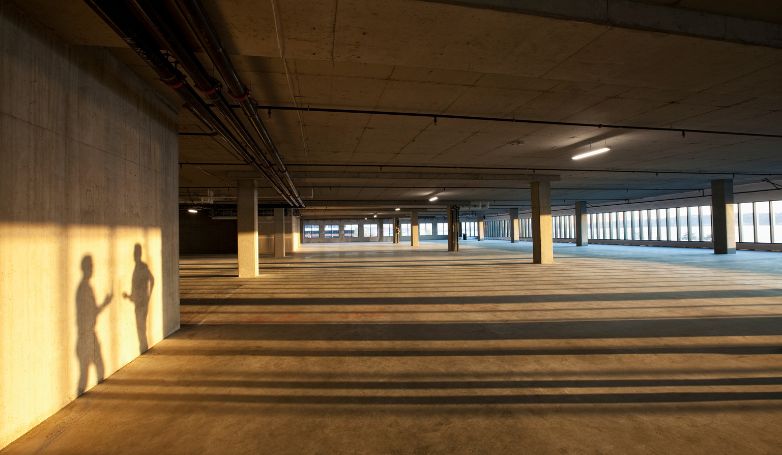
Here are some frequently asked questions (FAQs) about concrete parking lot repair, providing insights and solutions to common challenges:
How do you repair concrete paving?
Repairing concrete paving typically involves several steps: identifying the extent of the damage, cleaning the area, fixing cracks and potholes, and applying a sealant. The process starts with a thorough assessment to determine the type and severity of the damage. Cracks are filled with a suitable concrete filler or sealant. For larger issues like potholes, a concrete patching compound is used. Once repairs are made, sealing the surface protects it from future damage and extends its lifespan.
How do you repair outdoor concrete?
Repairing outdoor concrete involves cleaning the damaged area, removing any loose or crumbling concrete, and then applying a concrete repair mix. For cracks, a concrete crack filler is used. If the surface is uneven or has extensive damage, resurfacing may be necessary. It’s important to choose a repair material that matches the existing concrete in terms of texture and color for a seamless repair. Finally, sealing the repaired area helps to protect it from weather elements.
How can deteriorated concrete be repaired?
Deteriorated concrete can be repaired by first removing any loose or damaged concrete. The area should then be cleaned thoroughly to remove dirt and debris. For small areas, a concrete patching compound can be used to fill in the gaps. For more extensive deterioration, a complete resurfacing might be needed. After the repair material has been applied and has cured, sealing the surface is recommended to protect against future deterioration.
Can crumbling concrete be repaired?
Yes, crumbling concrete can be repaired. The process involves removing the crumbled pieces and cleaning the area thoroughly. Afterward, apply a concrete bonding agent before filling the area with a high-quality concrete repair mix. For larger areas of crumbling, it may be necessary to use a form to hold the repair material in place as it sets. Once the repair has cured, applying a sealant will help to protect the area from further damage.
Conclusion
Prevention is the key to saving you time and money. By addressing concrete parking lot repairs as soon as issues occur, you’ll be able to extend the life of your parking lot for years to come. Following a regular parking lot maintenance schedule, you will improve your concrete parking lot’s appearance and keep it safe for pedestrian and vehicular traffic. Concrete parking lot repair and maintenance is an ongoing process that should be handled by a professional contractor.
If your business requires concrete parking lot repair, locate a paving contractor near you.


